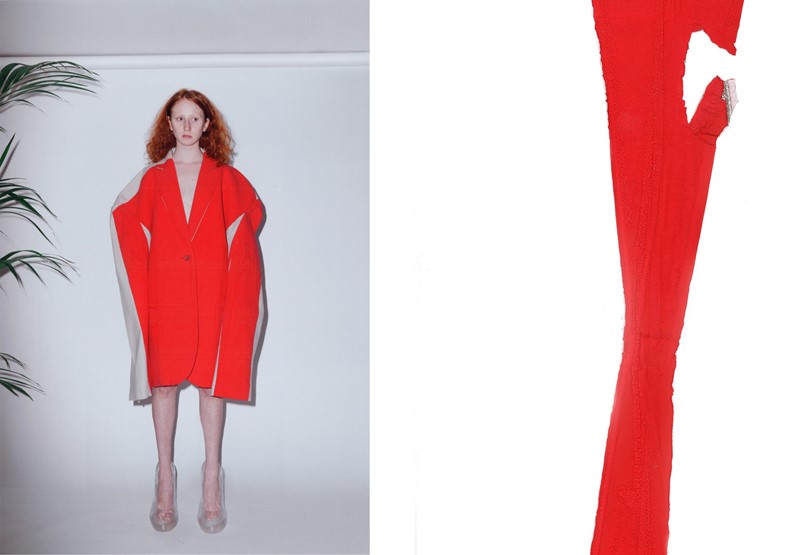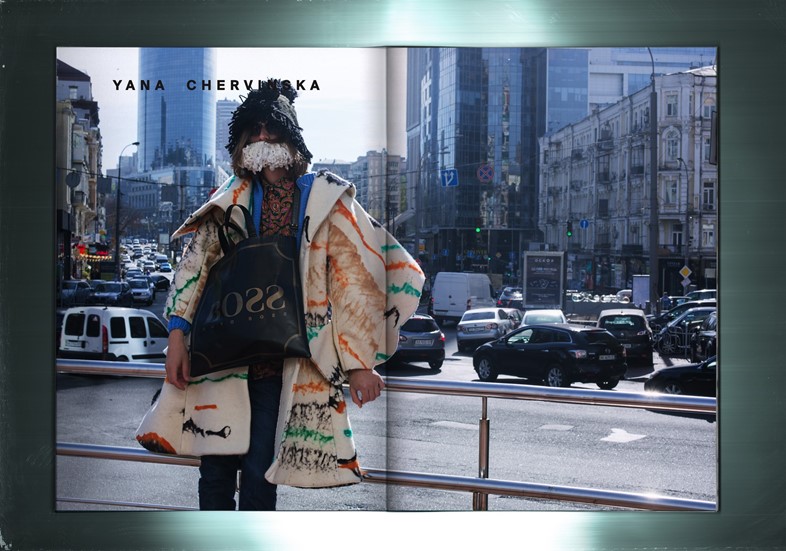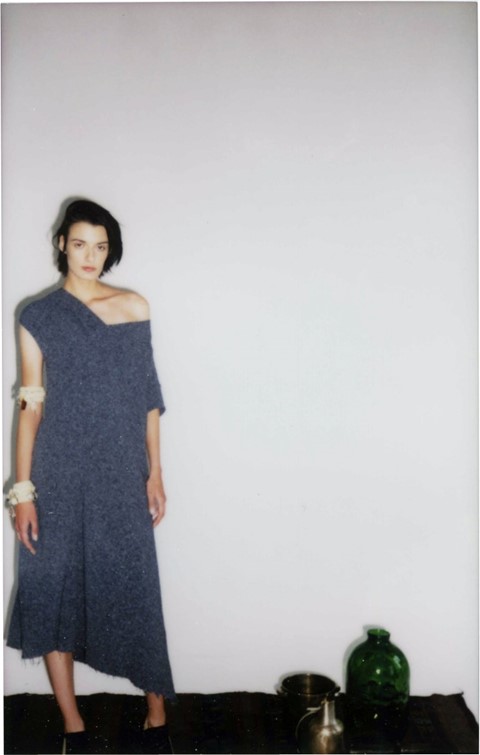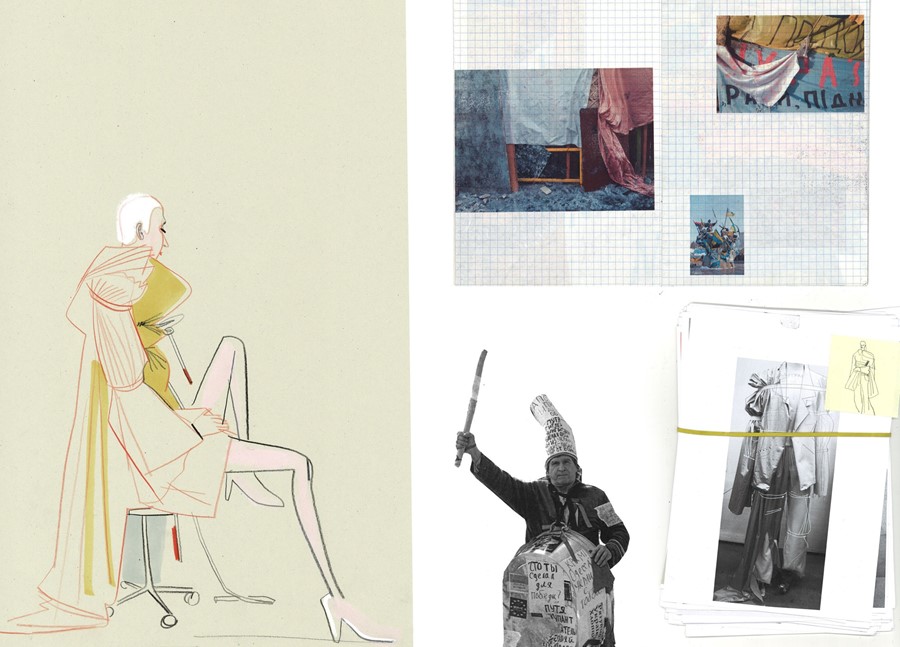In a schedule dominated by oligarchs, these innovative, self-funded talents are a beacon of hope, writes Rebecca May Johnson
While fashion week is about the clothes on the runway, it’s also an insight into the socio-economic and political situation of the city in which it takes place. Last February, designers at Ukrainian Fashion Week made bulletproof vests for those involved in violence just around the corner from catwalks in Kiev. This year, while the civil war is largely confined to the east of the country, thousands coursed through the city centre for a far right march in support of military heroes and army trucks were stationed throughout the city. Fashion week takes place in a recently disused weapons arsenal – a vast network of beautiful, brick-built spaces with high ceilings – but its military connection is not easily put out of mind.
Ukraine is a country of super rich and poor (there is no middle class) and its corrupt political establishment, like in many post-Soviet countries, is dominated by a few individuals with immense wealth and power: oligarchs. Accordingly, this is reflected in its fashion week. A significant number of designers who show during the main schedule are funded by personal wealth and the front row is populated by a peer group of rigid-faced socialites who indulge in a marathon of posing for cameras with huge flash rigs before each show. International buyers and press are absent from proceedings, and it’s personal patronage – making-to-order for wealthy clients – that constitutes sales for many brands here.

The recent crash in the Ukrainian hyrvnia currency has been a problem for retailers in Kiev. Avant-garde emporium Prototype, which bought A/W15 collections from French brands in Euros when the exchange rate was 30% better, now has to sell them at what looks like marked-up prices compared to stores in Paris or Milan. Ukrainian designers who want to sell or buy cloth within Europe are also hit by the exchange rate, as well as protectionist EU taxes: it’s tough outside the free trade zone. Local stores are often unwilling to buy Ukrainian designers, due to the preference for European luxury among local consumers, and a lack of confidence in brands’ ability to deliver product. The Ukrainian designers that can make international sales make them in Paris, where those with enough cash set up showrooms.
However, talented designers fight their corner, and there were a number of standout shows and presentations during what was a really well organised fashion week put on by founders Iryna Danylevska and her husband Vladimir Nechiporuk — long time advocates of Ukrainian fashion.

Fashion School Rebels
Eight emerging designers were selected to collaborate with London based Foxall Studios to make a fanzine in four hours as part of a project funded by the British Council. The talented young designers involved are friends and bonded through their rebellion against the relic of the still-Soviet fashion education system in Kiev. “I learned nothing there in 5 years. It was like: if you put fur here, it must also go here, if you are going to make a brown trouser suit, it must be like this – so old fashioned!” declared Yasya Khomenko, who will have a presentation at London Fashion Week in February as part of the International Fashion Showcase. “I took courses outside of college to teach myself,” she continued. Khomenko, who grew up in a family of artists, mixes artistic practice and fashion illustration with design, and often shows her collections – that fuse historical reference with pop art – in performance pieces.
Masha Reva, who first trained in Kiev, won funding to do the MA at Central St Martins, which she completed this summer. “The teaching style is so, so different”, she said, “there is no creative development here, it’s about how to make certain old fashioned garments...” Yet Masha, working on projects with friends and hunting out sponsors, has already featured in an impressive number of high profile stores while still a student, including Opening Ceremony, Joyce in Hong Kong, Hunting and Collecting in Belgium, and has collaborated with Vogue Italia and Milan design week, among others. The lookbook for her CSM collection – styled by Cate Underwood – is filled with the images of Maidan square violence, flags, bonded bodies and political resistance that inspired the architectural garments alongside that are suggestive of makeshift, precarious defences.
Bevza
While some shows during Ukrainian Fashion Week were too long and inappropriately styled, Svetlana Bevza presented a highly polished 90s production, complete with grungy shoegaze soundtrack including the gorgeous ‘For Love’ (1991) by recently reformed Lush. Styling was precise, and conjured ideas of a deconstructed 1990s ‘working-woman’ dreaming of her teenage years. Grown-up dress lengths and suiting with low office heels in burgundy suede were undercut by hems that had been let out with the crease still showing, chokers round the neck, and stickers stuck to models’ faces – a nod to pre-digital teen culture of secret diaries and stickers. The palette of white (Bevza’s signature hue), grey, beige, mustard, lilac and midnight blue velvet was on point, and the curve ball of the collection was provided by the last few dresses in a shaggy faux fur. Standouts included a white, calf-length crepe dress with fringing provided across the décolletage by frayed edges and a let down hem.
Frolov
The fierce and precarious talent of Ukrainian fashion is Ivan Frolov. His invitations came in the form of brightly coloured silk handkerchiefs, a clue to his inspiration: the ‘hanky code’ that arose in 1970s New York gay culture, where colours and placements of handkerchiefs denoted specific sexual fetishes. Like the designers involved in the fanzine, he too complained of the poor quality of the Soviet fashion education in Kiev – so perhaps it was fitting that subversive show was held in the former Soviet teaching headquarters. The handkerchiefs were transformed into whole garments across the collection that mixed lingerie and asymmetric silk slips, dressing gowns, flares and sheer dungarees, contrasting with jewel toned rough silk and velvet suiting for men and women. The audience were made painfully aware of their position as erotic voyeur to the scantily clad women as each model mounted the podium in front of them, turning around so that both front and back could be viewed. The first look of a sheer black, calf-length diamante studded dress with semi-sheer peach tone flares underneath on a model with a shaved head set the tone for a risk-taking show that, while less polished than Bevza’s, was perhaps more memorable.

Litkovskaya
I managed to visit Lilia Litkovskaya’s breeze block studio – for which it was necessary to clamber across a rubble filled courtyard – just before leaving Kiev. Due to some of her collection having been held up in her Paris showroom thanks to buyer interest, she missed her slot in Kiev and would show ten days later. Litkovskaya grew up in a family of Soviet-trained tailors, where she developed an early interest in the interplay between the fabric and structure of garments – a fact evident in her clothes. Among the S/S16 pieces that had made it back from Paris, we saw a white lace trench coat whose delicacy was given a counterpoint by a rubberised finish, pants in muted blue leather that looked like denim, and an exquisite long tobacco leather coat.
Litkovskaya visits Première Vision textiles fair in Paris to hunt for her cloth, and told us of pleading with a specialist fabric manufacturer that usually only works with big French luxury brands to buy a quantity of a sequin fabric that they would not normally permit. The result? Her S/S16 collection features a remarkable sequin fabric, whose colour and texture change when touched that was worked into dresses, jumpsuits and shirting. Litovskaya has built her business slowly, and eschews local front row celebrities in favour of a small, professional audience of press and buyers. She doesn’t have big advertising budgets, and works with emerging Ukrainian artists and photographers, such the A/W15 video directed by war photographer Sergii Morgunov with sound design by Mykita, which conjures the atmosphere of a cold war rendezvous in a blown out building. In her fifth season at Opening Ceremony, and with a slew of other stockists including big Parisian and Korean stores lined up for spring, Litkovskaya is taking off.
